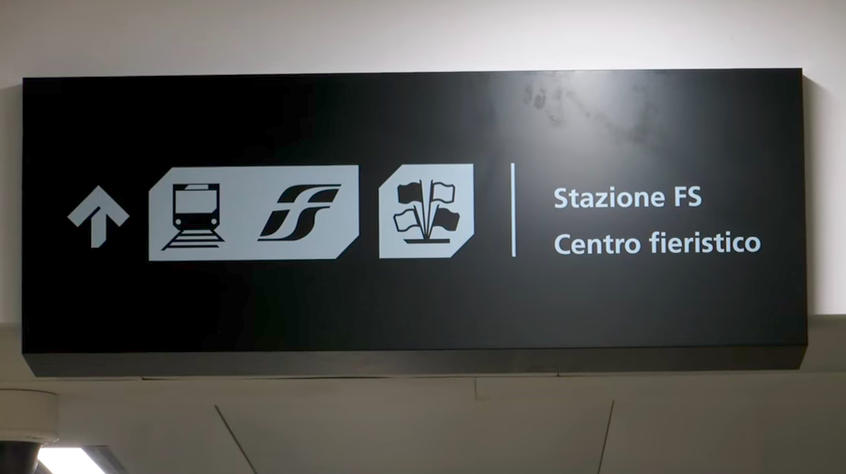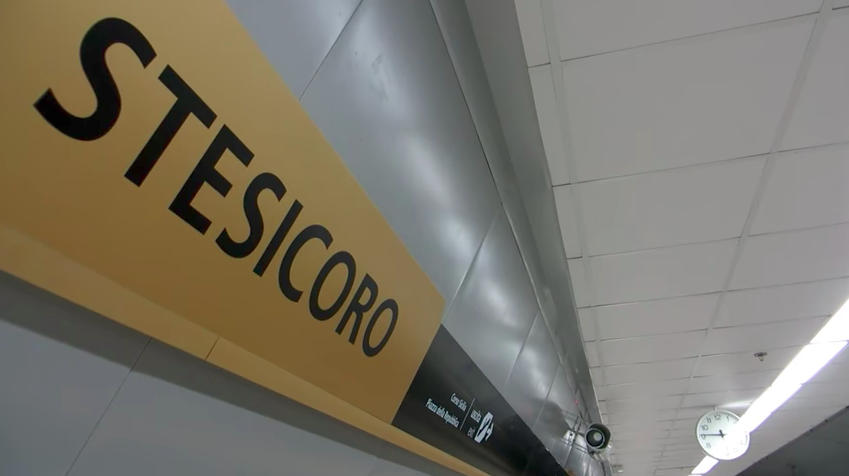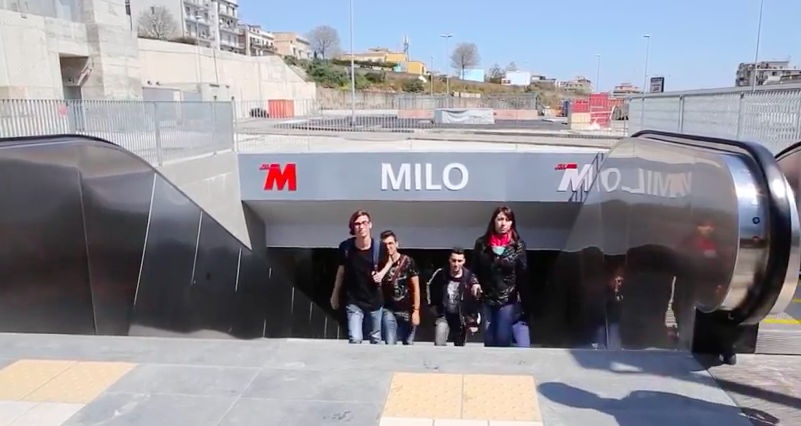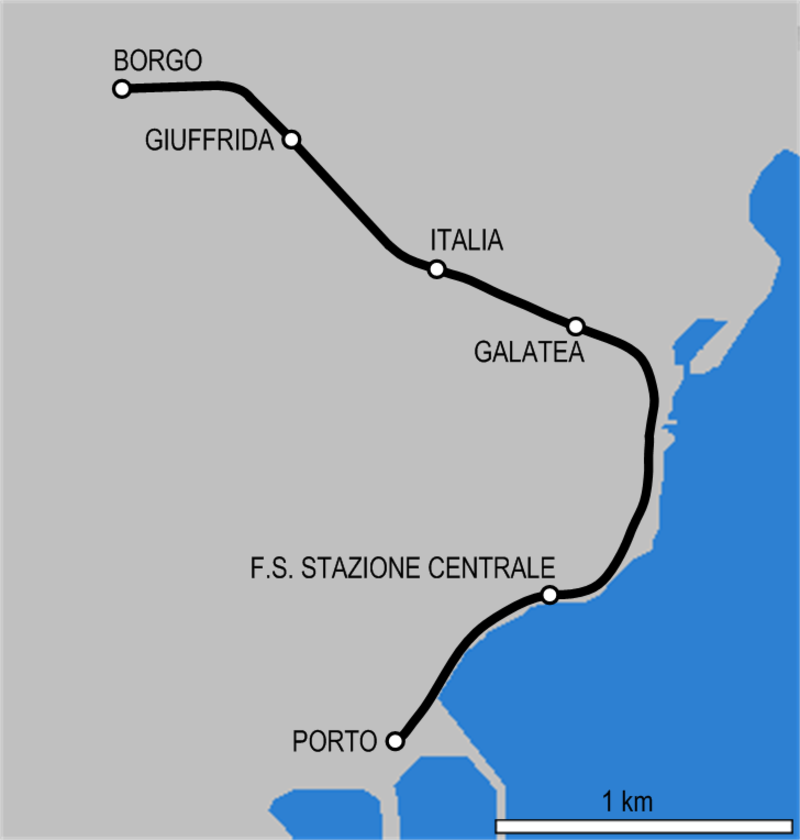The Catania Metro is a transportation system with a single line, and a railway of approximately 9 km long. It has 11 stations, and has a departure frequency of 10 minutes. It takes 14 minutes to travel through all its stations. The standard ticket costs 1 euro, which offers a ride for a maximum time of 90 minutes. The metro is operational from Monday to Saturday, from approximately 6:40 am until 9:00 pm. It is closed on Sundays and holidays. The metro does not go to the airport, but it allows transfers with the bus service to reach it.
Metros in Italy: Catania Metro
Located in the east coast of Italy, Catania is the second largest city in Sicily. With a population of 1.7 million inhabitants in the metropolitan area, Catania is the sixth most populated city in the country. Its origins date back from the 8th century B.C.E. A fun fact is that this city has been destroyed 7 times due to volcanic eruptions and earthquakes. This city’s streets have a lot of interesting history and culture, and is also a leading city in infrastructure with its trains and streets. It has had such a big population growth in the past decades that, in the late 70s, experts warned that it would be necessary to build a massive transportation system that would cover the transportation demand for the public.
In 1986, the construction of the metro began, and was given the name “Metropolitana di Catania.” The construction continued until 1991, when the last wall within a tunnel blocking the entrance to the city was demolished. It was inaugurated on 1999 with the opening of six stations, offering rides to the Borgo neighborhood with Oporto. During the course of the new millennium, the metro service has been extended to give transportation to the downtown area. Although there were a lot of issues during the construction, there are still plans of expansion and modernization.
Lines and stations
The Catania Metro only has one line. It has a railway junction in the Galatea station, in which one of the roads allows trips to the port. Currently, the metro has 11 stations, with a railway length of 8.82 kilometers. The railway network is relatively short, since it takes 14 minutes to travel the entire metro network from end to end. The metro has a daily ridership of around 6,000 passengers, and a yearly ridership of 704,000 passengers. The estimated departure frequency is 10 minutes.
Stations
Nesima: This station offers service to the inhabitants of the district of the same name. It is a new terminal, which was inaugurated on March 30th, 2017. It is located parallel to a surface level train station of the Circumetnea railway, also called Nesima station (Stazione di Nesima). This last station opened to the public on the following day of the inauguration of the Nesima metro station. The Nesima metro station is located underground. It has three exits, four escalators, and two elevators for people with disabilities. In the metro’s maps, this station is blue. Near the station, you can find the Nesima sports complex, which is comprised of the Palanesima and the municipal pools. Similarly, you will find near the station the San Pío X Church and some school buildings.
San Nullo: This is the following station after the Nesima station. It was inaugurated on the same day as Nesima station, on March 30th, 2017. It is orange on the metro’s maps. It is located on the neighborhood of the same name, San Nullo, among the streets of Antonio Merlino and Sebastiano Catania and the Antoniotto Usodimare Avenue. It has four entrances. The facilities have two escalators, two elevators for people with disabilities, and a closed-circuit television camera network to guarantee safety.
Cibali: It is located in the neighborhood of the same name, between the streets of Galermo and Bergamo. Here, there are transfers available to some bus lines that offer trips towards and from downtown Catania. Like the previous stations, it was opened to the public in 2017. Near the station, you will find the Angelo Massimino stadium in Piazza Spedini; the historic site of the Faculty of Agriculture of the Catania University in the Valdisavoia region; and the “Principe Umberto” school.
Milo: This is a Metropolitana di Catania station that is yellow in the metro’s maps. It is located in the west of the Borgo neighborhood, between the streets of Milo and Bronte. It has three entrances, two escalators, two elevators, and access to a big parking lot. This parking lot was funded entirely from money coming from tourism in Catania. It is linked to the BRT 1 bus line, which is managed by the AMT firm. This bus line offers transportation to the northern part of the college region and all of the college faculties located in this area. These buses also go to the University’s Sports Center, the Biology Tower, the University’s Hospital, the National Laboratory of Nuclear Physics, and the Faculty of Agriculture.
Borgo: This was one of the first stations to offer transportation in the Catania Metro. It was inaugurated on 1999, the year when the Catania Metro was inaugurated. This station was a terminal for the metro until 2017, when Nesima became a terminal. It gives transportation to the Etnea Street, which is located in the neighborhood of the same name. Near this station, the passengers can find many places of interest, such as the Vincenzo Bellini Musical Institute, the Institute for the Visually Impaired, the Botanic Garden, and the Gioeni Park. It is also close to many educational institutions, and Plaza Cavour.

Giuffrida: Just like the Borgo station, it was inaugurated on 1999 as one of the first sections of the metro. Located in one centermost regions of the city, it has six entrances four escalators, and two elevators for people with disabilities. Within walking distance from the stations, there are many offices, educational institutes, banks, and many stores. Some other nearby places of interest are the Workplace Tribunal, the Falcone Park, and the Vulcania Park.
Italia: this station was also part of the first stations to be inaugurated for the Metropolitana di Catania during the year 1999. It has six exits, two escalators, and two elevators for people with disabilities. Since it is located in the center of the metropolis, it has access to important places such as the Tribunal, the District Tribunal, the Administrative Tribunal for the Educational Office, the Science Palace, and the headquarters of the faculties of geology and economics of the University of Catania.
Galatea: Its opening was in 1999, and was one of the first stations for the metro. It is located to the south of the Jonio Avenue. It has six exits, four escalators, and two elevators for people with disabilities. Due to its location, this station allows users to travel to the coastal region. Also, it is the only station from the Catania Metro with a railway junction. Some of the train head to Porto, and others head to Giovanni XXIII.
Porto: It is located near Catania’s port. It was one of the terminal stations of the Circumetnea railway. In 1999, it was reopened to the public, but this time, it became a terminal for the Metropolitana di Catania.
Giovanni XXIII: It is located in the Papa Giovanni XXIII plaza, and it was inaugurated on 2016. It is the biggest station in the Catania Metro. The main exits are located near the plaza. It has escalators, and elevators for people with disabilities.
Stesicoro: Its name comes from a nearby plaza called Stesicoro. It was inaugurated on the year 2016, just like the Giovanni station. It currently is a terminal for the metro. However, once the San Domenico station is built, San Domenico will be the new terminal. Stesicoro station is recognizable due to its white and gray colors that decorate its internal walls. It is located in downtown Catania. It has escalators in the entrances, and four elevators for people with disabilities.
Fares
The Catania Metro, unlike most transportation services of this kind, does not have single ride tickets. Instead, it uses time-based tickets. This could be a disadvantage if you want to get a round trip ticket. However, as a benefit, the fare is relatively low. The tickets can be purchased in vending machines, which can be found in any of the 11 stations. Additionally, they can also be purchased on ticket booths and authorized kiosks. The tickets available to the general public will be shown below:
Biglietto A Tempo: With this ticket, users can enjoy 90 minutes of unlimited rides in the metro system. It is quite convenient for anyone that needs to make quick errands, since they can make the most out of the hour and a half that the ticket offers. However, it is not recommended if you are planning to use the metro many times within a day. It costs €1.
Biglietto Giornaliero: With this ticket, the Metropolitana di Catania passengers have the possibility of using the metro’s facilities during an entire day. It is convenient for anyone that makes multiple trips in the trains during an entire day. It can also be useful for tourist that visit Catania, since they can use subway for unlimited rides for up to 16 hours. This ticket costs €2.
Biglietto Integrato Bus: With this ticket, the passenger will be able to use the metro service, and will also be able to make transfers to the buses of the AMT firm, which offer trips to all of Catania. This is one of the best tickets for the user, since it allows 120 minutes of unlimited journeys in trains and city buses. If this ticket is used efficiently, the passenger could travel long distances for a relatively low cost, since its price is €1.2.
Abbonamento Mensile: with this ticket, any citizen has the possibility of using the metro service for an entire month. If the passenger lives in Catania and frequently uses the subway service, this is the best ticket. It has a relatively low price compared to the price of other similar transportation services. Its price is €12.
Children under six years old, people over 65 years old, and people with disabilities do not have to pay to use the metro.
Schedule
The Catania Metro is operational from Monday to Saturday. It is closed on Sundays and holidays. The trains have a departure frequency of 10 minutes between morning and 3:15 pm. Then, between 3:15 pm and the time when the stations close, their frequency of departure increases to 15 minutes. During holidays or other special events, the metro stations will be closed. The metro staff will inform beforehand if the metro is closing due to special events.

The first train leaves the Nesima terminal at 6:40 am, while the first train from Stesicoro leaves at 7:00 am. During closing time, the last train from Nesima leaves at 8:45 pm, while the last train from Stesicoro leaves at 9:10 pm.
Connections
Each metro station offers transfers to bus lines and to the Circumetnea railway. The connections available are the following:
Nesima: In this station, the users can make transfers to the Circumetnea railway, which has a terminal at surface level, also called Nesima. It also offers connections to the bus lines 522, 621, 628N, 628R, 642, 702, and 932.
San Nullo: It only allows transfers with the buses from the AMT firm. The connections available are for bus lines 642, 733, 702, 628N, and 628R.
Milo: It only allows connections to two bus lines: the BRT1 and 740. It also has a parking lot.
Borgo: It offers a connection to the Circumetnea railway in the Catania Borgo station, which is located at surface level. Also, it has a bus station for urban and interurban buses. The urban bus lines available are 1, 4, 429, 432, 449, 536, 556, 744, and BRT1. Meanwhile, the interurban bus lines are AST, FCE, and Etna Trasporti, which are in charge of offering transportation to the outskirts of the city.
Italia: This station has bus stations for the bus lines 534, 935, 443, 530, 628N, 628R, 722, 431N, and 431R. It also has transfers available to the suburban buses from AST, FCE, Etna Trasporti, and ISEA.
Galatea: Just 500 meters from the station is Europa station, connected to the trains of Ferrovie dello Stato (FS Italia), which operate on standard gauge. Likewise, there are several bus routes including 443, s2, 443, 530, 534, and 935.
Porto: This terminal offers direct trips to the Catania port. Also, it offers transfers to the interurban buses that go to Misterbianco, Motta Sant’Anastasia, Piano Tavola, Paternò and Adrano.
Giovanni XXIII: This is one of the stations that offers the highest number of transfers in the metro system. It allows connections to the urban buses ¼, 2/5, 4/7, 429, 431N, 431R, 432, 439, 443, 448, 449, 530, 534, 536, 556, 628N, 628R, 925, 927, 932, ALIBUS, L-EX, and S2. It also offers transfers to buses from AST, SAIS, Baltour, and Eurolines, which offer trips to the rest of Italy, and to other European countries. Also, the passengers can make a transfer to the Circumetnea railway in the Catania Centrale station.
Stesicoro: Due to its location, it offers connections to many urban bus lines. These bus lines are 1, 2, 4, 5, 7, 429, 432, 448, 449, 534, 536, 556, 902, 927, 935, and ALIBUS. It also offers connections to buses 702, 722, 726, 733, 740, 744, 621, 902, 925, 927, 932, and 935.
Rules
Restrictions:
- Under no circumstance the users will be allowed to smoke within the metro’s facilities.
- Begging is not allowed in the stations and trains from the metro.
- It is prohibited to bother or distract in any way the members of the metro staff.
- Each user can only use a single seat in the metro’s trains.
- All of the emergency equipment should only be used during dangerous situations.
- You shall not litter the train’s tracks.
- You shall not distribute pamphlets or any other kind of publicity without previous authorization in the metro’s
- It is strictly prohibited to assault other passengers of the metro.
- If you want to listen to music, you can only do so by using headphones. This way, you will not disturb other passengers.
- If you carry any hazardous or dangerous materials, you will be denied access to the metro’s facilities.
- To access the metro’s stations, you will need to use shoes.
- Consuming alcoholic beverages in the metro’s facilities is not allowed.
- Passengers shall not enter areas that are of exclusive use for the Metropolitana di Catania staff.

Tips
- Be careful while boarding the train, since there is a gap between the platform and the train, which could cause you to fall.
- If you are waiting on the platform, stay on the side of the train’s door when it arrives to make it easier for the rest of the passengers to exit the train first.
- Once the train’s doors are closing, do not board nor disembark the train.
- Once the trains starts moving, do not disembark the rail cars.
- Get close to the train’s doors once you are close to reaching your destination.
- Avoid leaning on the train’s doors.
Carrying pets:: You can carry your pet in the Metropolitana di Catania, as long as it is a small animal and is bound to a leash. This way, your pet will not disturb other passengers.
Small children:: Children under six years old can travel for free, as long as they are accompanied by their legal guardian. Also, they should sit on their legal guardian’s lap, not on a seat.
Bike transportation:: Users can transport their bicycles on the Catania Metro. Any passenger can carry their bike on a train by just showing a valid ticket. Bikes are allowed from Monday to Friday, from 9:00 am until noon. You will have to wait until 3:00 pm to be able to carry your bike on the train again. Bikes are allowed all day on the metro during Saturdays.
Connection to the airport
The Metropolitana di Catania does not travel directly to the Aeropuerto Catania-Fontanarossa airport, but the passenger has the possibility of reaching the airport from downtown Catania by using the bus service. First, the passenger will have to board the metro, and head towards the Giovanni XXIII station (also known as Catania Centrale). After exiting this station, the passenger will find the various bus lines. They will need to ride the Alibus bus, which has a departure frequency between 20 and 30 minutes. The buses from this line will bring the passenger directly to the airport. The trip lasts approximately 25 minutes, and has a cost of €4.
Similarly, to go from the Aeropuerto Catania-Fontanarossa airport to downtown Catania, the passenger will have to exit the airport and wait for the Alibus buses. These buses will reach many zones within the city. If you do not wish to go to downtown Catania, you could make transfers to other metro stations.

Future expansions
Currently, the firm that manages the Catania Metro is working on the expansion of the train network, as well as adding five new stations, which are:
Fontana: It will be located in Felice Fontana Avenue, which is close to the Garibaldi-Nesima hospital complex. It will have a parking lot that will have enough room for 850 vehicles. It will be opened to the public on the first months of 2018.
Monte Po: It will be located in the crossroads between the SS121 roundabout, and the beginning of the Corso Carlo Marx Avenue. It will be located nearby the Monte Po district, which is why this station has its name. The inauguration date is predicted to be during the first semester of 2018.
San Domenico: It will be located in the intersection between the Reclusorio Lume Avenue and Orto San Clemente, to the west of Etna Avenue. It will be on a strategic location of the historic center. Its opening date is predicted to be on the year 2019.
Vittorio Emanuele: It will be located in front of the Hospital Vittorio Emanuele, in the Plebiscito Avenue. Its opening date is planned to be on 2019.
Palestro: It will be located on the Plaza Palestro, and its inauguration is planned to be on 2019.
Nearby attractions
Stesicoro station is part of the project “Museo diffuso Della Città di Catania”. The objective of this project is to teach the citizens about the local culture, by using theme stations. Stesicoro station is themed as the Roman Amphitheater of Catania, which is one of the biggest amphitheaters from the Roman Empire. Also, the monumental ruins of the Roman Amphitheater of Catania are located within walking distance of Stesicoro station. In the walls of this station you can watch graphic representations of this amphitheater, and you can read the history of how it was built. Also, there are plans to include copies of the local artifacts found by archaeologists. Alongside these copies, there will be LED screens on the walls that will show a virtual reconstruction of the places where these relics were found.
Catania Metropolitana map
- Also Known As: Metropolitana
- Passengers/Day 1600
- Fares: 1€
- 24h operation: No
- Air Conditioning: No
- Walk between platforms: No
- Driverless trains: No
- Screen Doors Platforms: No
- Operator: FCE
- € 1
- Catania Metro Official Website
- Tlf: +39 095 541 111
Help us
If you consider that the information we provide is wrong, not accurated, outdated, translation contains errors, and you would like to help us to improve the file...you can contact us here.
Feel free to contact us if you dont find the system you're looking for and we'll add it as soon as we can!
Thank you very much!










